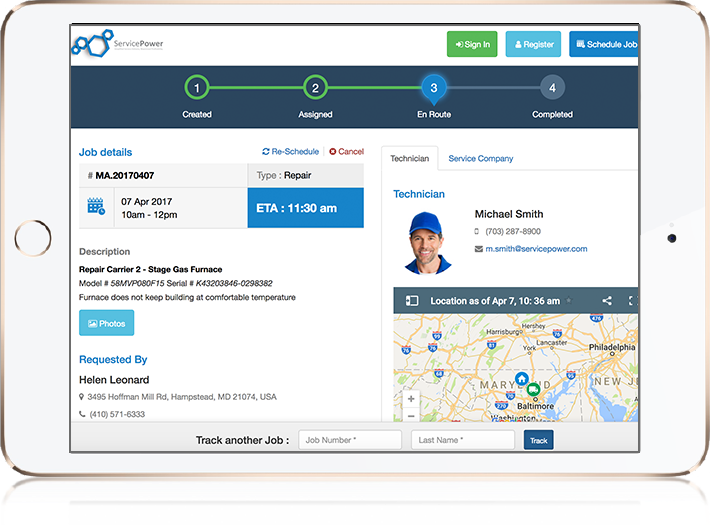How Mixed Workforce Management Software Improves CX
Exceeding customer expectations begins with meeting the needs of the workforce that serves them. Whether employees or contractors, managing...
3 min read
 ServicePower
:
October 04, 2021
ServicePower
:
October 04, 2021

Workforce management software has quickly become essential for a field service company to maintain its competitive edge. Why? Because workforce management connects all of your organization's processes – from repair scheduling to human resource management, data collection, and forecasting.
This blog discusses how workforce management software empowers field managers to take the leap from manual to automated processes, resulting in a higher-quality customer experience.
In the same way, workforce management touches on many different business areas, so does workforce management software. However, in most cases, the primary focus is on field workforce management, including schedule optimization, mobility, and the various processes involved with managing a blended workforce of full-time employees and third-party contractors.
Suppose you have not used workforce management software in the past. In that case, you might be asking yourself, "What's the big deal?. Field service companies without workforce management software have other technology and processes in place that work to address those same issues."
And that's true. These processes, however, are typically manual and offer very little as far as service workflow optimization. Optimization takes the guesswork out of increasing technician productivity and time to ROI so field managers can feel confident they're delivering the best customer experience possible. In short, traditional manual processes, using disconnected technology, facilitate business as usual. This is not the goal of workforce management software.
Sizeable well-known field-service organizations worldwide such as G.E. Appliances, L.G., Electrolux, and Siemens recognize the impact of workforce management software on the customer experience. Here are some case studies that showcase how companies like these have successfully implemented workforce management solutions in their organizations.
This probably isn't the first time you're reading about a software platform's impact on the customer experience. For a good reason, Gartner Research estimates that by 2023, 60% of all customer service engagements will be delivered digitally or via a web-based self-service tool. Technology, however, does not diminish the importance of a qualified field manager.
The purpose of tools like ServicePower's customer portal is to provide field managers with additional intel about jobs and customer preferences. In turn, the managers are more capable of meeting client expectations.
Of course, field management software encompasses more than self-service tools, but right away, you can see how they might make a field manager's life easier. For instance, portals allow customers to attach photos and documents to specific jobs. Technicians can view an image of the exact equipment they're about to repair from anywhere. Portals give customers 24/7 access to appointment scheduling, which helps speed up the entire lifecycle of the job. And the list goes on.
Schedule Optimization
A busy work order schedule is a large part of why companies utilize workforce management software. Let's face it - even the most qualified field manager is prone to making errors when they're up against unmanageable scheduling challenges.
Enter a field manager's best friend – "Schedule Optimization." Schedule optimization refers to the process of scheduling work in such a way that you prioritize meeting the organization's goals. Essentially, you input your business's KPIs, and the workforce management software platform uses Artificial Intelligence (A.I.) technology to compare scheduling scenarios and determine which one is most likely to result in you meeting your KPIs. Often referred to as "smart scheduling," this process may sound intimidating but is really just an enhanced, modern way to accomplish what field managers have been doing for years.
Schedule optimization also considers a slew of other factors unique to your organization, such as parts inventory, skills and availability of your field team, and other "smart" data meant to empower your field managers.
Analytics and Reporting
While there are many reasons to implement a workforce management solution, software reporting features are most likely to appeal to seasoned field managers. Why? Data has become a significant focus area inside large organizations, but it has also grown in size and complexity.
Field data is becoming increasingly difficult to organize and analyze without the right technology. Workforce management software brings together data points from multiple departments, such as Human Resources, and sources such as customer satisfaction surveys. This merging and funneling of information give field managers a comprehensive and real-time view of the business.
Field managers can also benefit from the ease and convenience of using workforce management software to generate reports – it's as simple as dragging and dropping the information you need. And how you format and display the reports is customizable at both the organization and user level.
For instance, you can create custom dashboard card views of various reports and sort them according to specific KPIs or geographic areas. Additionally, busy field managers can save time by having certain reports generated and emailed to them automatically. In short – the analytics and reporting options are endless, and like most other aspects of workforce management software, they are purposely customizable.
Conclusion
In the same way, having the right equipment is essential to your technicians' success; field managers need customizable technology solutions designed explicitly for field workforce management to succeed in today's fast-paced field service industry.
Field managers, even those not already familiar with all aspects of workforce management, will quickly see the benefits of a well-executed workforce management solution, especially those wanting to create a customer-centric service experience for their clients. After all, the goal of workforce management software and a stand-out field manager is the same - to make sure your customers receive excellent service every time – faster and better than your competitors.
Interested in learning more about how workforce management software helps to empower field managers?
Request a demo of ServicePower's suite of field service management solutions.

Exceeding customer expectations begins with meeting the needs of the workforce that serves them. Whether employees or contractors, managing...

When your business model, backed by your current stack of enterprise workforce management software, has been working well, it's hard to see a reason...

Ask any talent acquisition leader in the field service industry and you’re likely to hear a similar story: It’s hard to find qualified technicians....